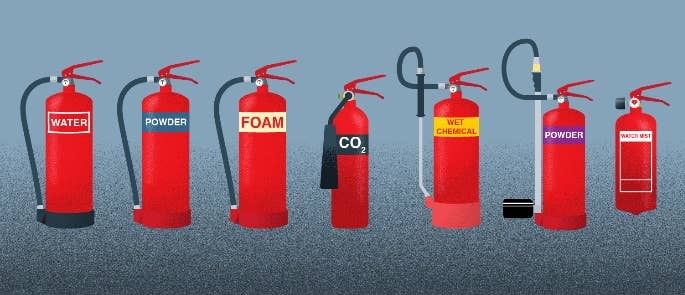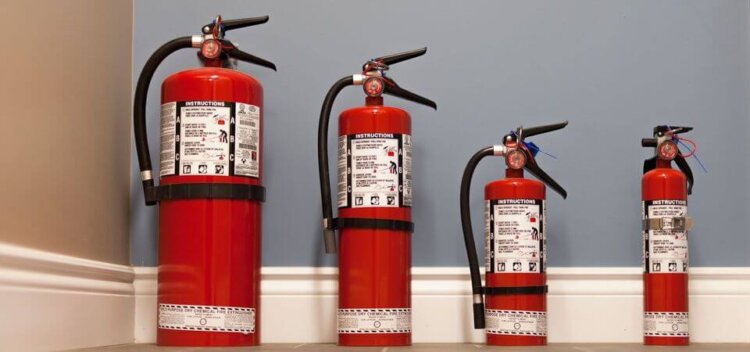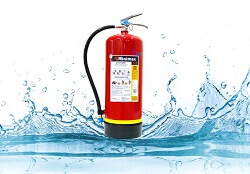August 15, 2023
When it comes to fire extinguishers, it can be not very clearly trying to determine which rating you need. Do you need a Class A, B, C, or D extinguisher? What is the difference between them? In this blog post, we will break down the different ratings and help you decide which one is best for your needs.
Fire Extinguisher Ratings and Classes
There are different fire extinguisher classes, each with its function and purpose. But how do you know which one to choose? The answer lies in understanding its ratings and types.
In general, there are five different fire classes:
Class A
Class A extinguisher fights ordinary combustibles such as wood, paper, and fabric.
Class A extinguisher uses a dry chemical agent that smothers the fire by creating a barrier between the oxygen in the air and the fuel of the fire. This barrier interrupts the chemical reaction that is taking place and prevents the fire from spreading.
Class A extinguisher is easy to use and can be found in most buildings. They are often small and portable, making them easy to store and carry around.
If you have a Class A fire, it is essential to remember that you should never try to fight the fire yourself. Always call the fire department and let them handle it. Trying to fight a fire on your own can be very dangerous, and you could get hurt.
Class B
Class B fire extinguisher is suitable for fires involving flammable liquids, such as petrol, gasoline, oil, or grease and paint. They work by smothering the fire with a blanket of foam, which cuts off the oxygen supply and prevents the fire from spreading.
Class B fire extinguishers typically have a red band around them, indicating that they should only be used on flammable liquids. If you’re not sure which type of fire extinguisher to use, always err on the side of caution and use a Class A extinguisher instead.
If you’re using a Class B extinguisher on a large fire, it’s important to remember that you may need to recharge it after a few minutes. Always follow the manufacturer’s instructions, and never use an extinguisher on a fire that is too large to handle.
Class C
Class C fires are those that involve electrical equipment. Because water is an excellent conductor of electricity, it should never be used to extinguish these fires. The best type of fire extinguisher for Class C fires is one that uses carbon dioxide, dry chemicals, or foam.
A fire extinguisher is an essential part of any safety plan, but it’s important to know which type of fire to use for each class of fire.
Class D
A class D fire extinguisher is designed to combat combustible metals like magnesium, titanium, and sodium. These types of fires are often found in chemical or industrial settings. Class D fire extinguishers work by cooling the metal surfaces to prevent ignition.
A class D fire extinguisher is usually filled with a dry powder agent, such as sodium bicarbonate or potassium bicarbonate. The powder works to smother the fire by breaking up the chemical reaction that is taking place. Class D extinguisher is also designed with a more extensive discharge nozzle to help direct the agent onto the fire.
When using a Class D fire extinguisher, it is important to aim the nozzle at the base of the fire. This will help ensure the agent comes into contact with all the burning metal surfaces. It is also essential to keep a safe distance from the fire, as the heat can be intense.
Class K
Class K fire extinguisher is designed for use on cooking oil and grease fires. They are filled with a wet chemical agent that quickly cools the burning oils and prevents reignition. A class K fire extinguisher should be placed in or near commercial kitchens and any home where cooking is frequently done.
Most Class K fire extinguishers have a discharge hose and nozzle, making them easy to use. Aim the hose at the base of the fire and squeeze the trigger. The wet chemical agent will quickly cool the oils and help to prevent reignition. Class K fire extinguishers are essential to any fire safety plan, so be sure to place them strategically around your home or business.
The Most Common Types of Fire Extinguishers

There are many different types of fire extinguishers on the market, each designed for a specific fire. The most common fire extinguishers are carbon dioxide and ABC powder fire extinguishers.
Carbon dioxide extinguishers
It works by displacing oxygen in the area around the fire, suffocating it. They are most effective on Class B and C fires but can also be used on Class A.
ABC powder fire extinguishers
It works by smothering the fire with a fine powder. This interrupts the chemical reaction that is taking place and prevents the fire from spreading. ABC powder extinguishers are most effective on Class A, B, and C fires.
When choosing a fire extinguisher, it is essential to consider the type of fire that is most likely to occur in your home or business.
When it comes to fighting fires, time is of the essence. The faster you can put out the fire, the minor damage it will cause.
Choose the Right Size Fire Extinguisher

It’s essential to have a suitable size fire extinguisher for your home. The wrong size can be ineffective and increase fire risks. Here are some tips to help you choose the correct size extinguisher for your home.
- Check the environment in which it will be used. The size of the room, the type of materials present, and the number of flammable liquids are all critical factors to consider.
- Choose a fire extinguisher appropriate for the types of fires you are most likely to encounter. Class A extinguishers are for ordinary combustibles, Class B for flammable liquids, Class C for electrical equipment, and Class D for metals.
- Get one large enough to put out a fire but not so heavy that it will be difficult to use. A rule of thumb is that an extinguisher should be able to empty its contents in 30 seconds or less.
- Check the expiration date and ensure the fire extinguisher is charged correctly. Inspect it regularly to ensure that it is in good working order.
A fire extinguisher is vital safety equipment, but only if it is the right size and type for the job. It can lessen the extinguisher’s effectiveness if you choose the wrong one.
Additional Tips in Choosing the Right Fire Extinguisher
Type of Fire

Each type of fire extinguisher is designed to be used on specific types of fires. For example, a Class A fire extinguisher is ineffective on Class B or C fires. Likewise, Class B and C extinguishers will not work on a Class A fire. Choosing the correct extinguisher for the job is essential, as using the wrong type of extinguisher can worsen the fire.
Size of the Area
When choosing a fire extinguisher, you will also need to consider the size of the unit. The size is indicated by the “A” rating, with an A-rated fire extinguisher being the most minor and portable unit. The higher the A-rating, the more water or foam the extinguisher can hold.
Type of Extinguishing Agent
Finally, you will need to decide on the type of agent best suited for your needs. The most common agents are water, CO₂, dry chemicals, and foam. Water extinguishers are best for Class A fires, while CO₂ is better suited for Class B and C fires.
A dry chemical fire extinguisher can be used on all types of fires but are most effective on Class B and C fires. Foam extinguishers are best for Class A and B fires.
Now that you understand fire extinguisher ratings and classes, you can decide which unit suits your needs. Be sure to choose the right size and type of extinguisher for the job, and always keep one on hand in an emergency.
Fire Protection and its Importance
The National Fire Protection Association recommends a fire system in your properties. Any equipment or device is used to detect, extinguish, or prevent fires. This can include sprinklers, fire alarms, smoke detectors, and extinguishers.
Fire protection systems are essential to any building, as they help keep occupants safe in a fire.
Sprinkler systems
They are effective at extinguishing fires quickly. However, they can also be expensive to install and maintain.
Fire alarms and smoke detectors
They can alert occupants to fire to evacuate the building.
Fire Extinguishers
They can help to control them until the local fire department arrives.
When it comes to fire safety, there is no such thing as being too prepared. Installing a fire system in your building can help ensure that your occupants are safe in the event of a fire.
Home Fire Extinguishers

Home extinguishers have been assigned ratings by the Underwriters Laboratories (UL). Class A extinguishers are for ordinary combustibles, such as paper, wood, or fabric. Class B extinguishers are for flammable liquids, such as grease, gasoline, or oil. Class C extinguishers are for an electrical fire, such as appliances, wiring, or circuit breakers. Class D extinguishers are for metals, such as magnesium, titanium, or potassium. Class K extinguishers are for kitchen fires, such as grease or oil.
The Underwriters Laboratory has also established minimum standards for home fire extinguishers. These standards include an annual maintenance check, a pressure gauge that indicates whether the extinguisher is full or needs to be replaced, and clear instructions.
When choosing a home fire extinguisher, it is essential to consider the type of fire most likely to occur in your home. For example, if you have a fireplace, you will need a Class A extinguisher. If you have a kitchen, you will need a Class K extinguisher.
Choosing an appropriate extinguisher for the size of your home is also essential. A small home may only need a single extinguisher, while a larger home may need several.
Once you have chosen the correct fire extinguishers for your home, please read the instructions carefully and practice using them.
Conclusion
So, what do you need to know before purchasing a fire extinguisher? You should become familiar with the different types of fires and the other classes and ratings of extinguishers. This will help ensure that you select the proper extinguisher for your needs.
Different types of fires require other methods of extinguishing agents. Class A fires are doused with water, Class B with CO₂, Class C with dry chemicals, and Class D with foam.
The size of your home will also dictate the number of extinguishers you need. A small home may only require one extinguisher, while a larger home may need several.
And finally, be sure to familiarize yourself with the instructions and practice using your extinguishers. With some knowledge and preparation, you can be ready to handle a fire should one occur.
While no one ever wants to face a fire, being prepared can help make the situation less daunting. By understanding the ratings and classes, you can be sure to choose the suitable extinguisher for your needs. And by familiarizing yourself with the instructions and practicing using them, you can be confident in your ability to handle a fire should one occur.
